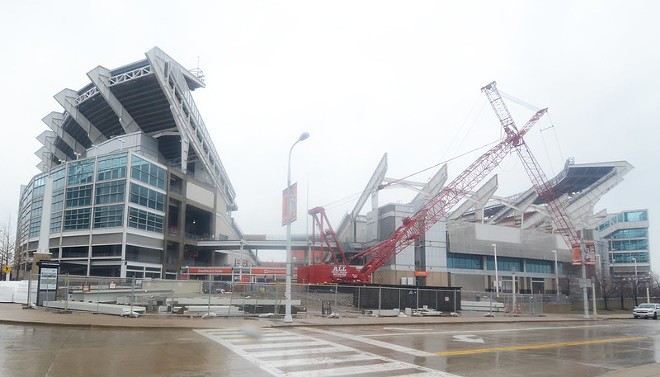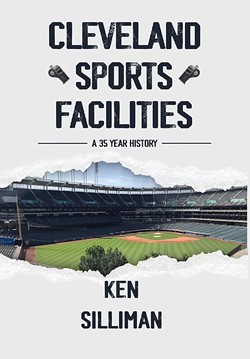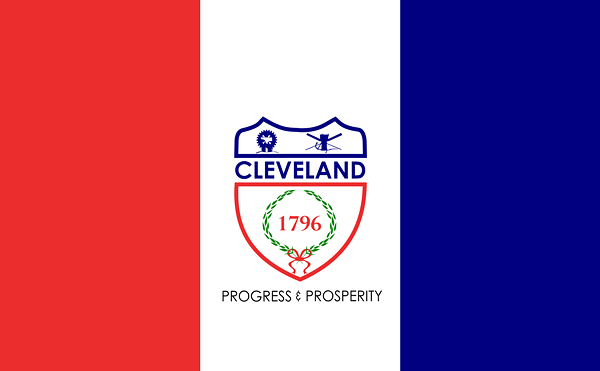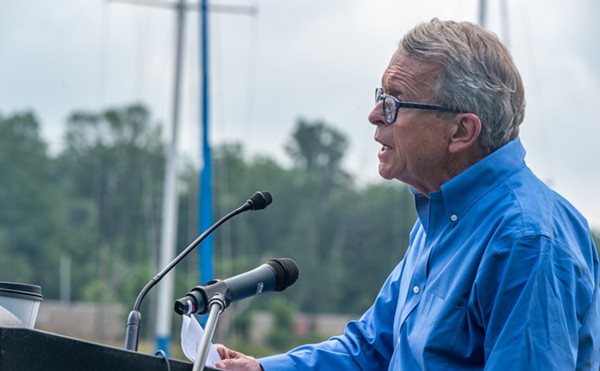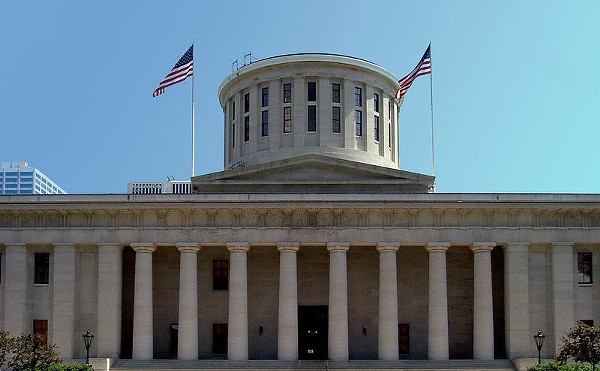Ken Silliman Gives a Front-Row Seat to Cleveland Sports Stadium and Arena Financing History, and Ponders What's Next
His book is a true behind-the-scenes look at Cleveland's deals with the Browns, Cavs and Guardians
By Mark Oprea on Tue, Dec 5, 2023 at 8:57 am
[
{
"name": "Ad - NativeInline - Injected",
"component": "38482495",
"insertPoint": "3",
"requiredCountToDisplay": "5"
},{
"name": "Real 1 Player (r2) - Inline",
"component": "38482494",
"insertPoint": "2/3",
"requiredCountToDisplay": "9"
}
]
As the city of Cleveland and the Browns continue negotiations on what to do with Cleveland Browns Stadium — chiefly, how much of the renovation costs should be shouldered by taxpayers — a new book from Ken Silliman is an illuminating and timely read.
Silliman has had a front-row seat and major role in how these discussions and deals have played out in the past, and in Cleveland Sports Facilities: A 35-Year History, he blends personal history with local lore.
For example, this bit from the book: The sports enthusiast, former city attorney and current chair of the Gateway Economic Development Corporation board had convened with NFL staff and City Hall officials at the Chicago O'Hare Airport Hotel. It was February 8, 1996, and Silliman and his team, including Mayor Michael White, had traveled two states to convince NFL president Neil Austrian of a decision that City Hall believed was dire for the public good: to keep, despite owner Art Modell's rebellious urge to move them to Baltimore, the Browns in Cleveland.
"If Cleveland continued its fight with Maryland, the civic agenda would remain divided," Silliman recalled about that meeting. "There was nothing more to discuss, and I knew it. It was time to bury the hatchet and accept a better deal than any other abandoned city had struck with the NFL."
Such is the tone of Silliman's book, which was released via Paper House Publishing in July of this year. Clocking in at 552 pages, Sports Facilities is undeniably a brainy, niche take on Cleveland's most beloved (and loathed) on-the-field moments and the behind-the-scenes civic choices that built those fields.
And Silliman is quite aware of his luck, being at the legal helm of the deals behind Browns Stadium, Jacobs Field and Gund Arena He writes cheerfully about being a "hard-core Browns and Indians fan" while attending Case Western in the 1970s, a fandom that continued through the decades.
"I was either fortunate enough—or philistine enough—to play a role in sports facility decisions for all three of Cleveland's major pro sports facilities," Silliman writes in the book's preface. "My childhood loyalties certainly motivated me to seek out these opportunities."
But Silliman is also an attorney. It's why the book could be read both as sports legal history and a play-by-play textbook, as one can imagine Silliman's negotiations with Austrian being shown on some locker room film reel. He even recommends, in the chapter on the notorious Gateway deal, the 1974 movie Missiles of October, a chronicle of the Cuban Missile Crisis, as a "superb negotiating primer." Maybe it'll help, Silliman says, handling Cleveland's fraught "voodoo economics," the question of the economic impact on the city and the city's bottom line in these deals. "I can offer no better advice to attorneys."
If readers are to sift through the occasional meeting-minute vibes and the expenditures sheet, they'll find a passionate philosophy about Cleveland, if not American, sports.
But the financial health of the city is forever entwined with the performance of its teams. Despite, Silliman writes, those "rare exceptions"—the Cavs during LeBron James' return, the Indians in the late 1990s—Cleveland sports has long relied on yearly player drafts over prized free agents. We see this, he says, in the Major League-era Indians, in the Browns from 1987 to 2017, with Baker Mayfield's arrival. In Silliman's mind, there's a cultural domino effect that stadium builders seem to get high on: build a state-of-the-art facility with best tax deal, move in simmering team, revitalize area around stadium, pray championships will come.
These moments, laced with the hope that Cleveland sports runs on, are eternally returning. At one instance, in midst of advising Mayor Frank Jackson on the $140 million renovation of the arena, Silliman undergoes what seems to be a laughable case of deja vu. A meeting with the Cavs, the Indians and County Executive team "deteriorated" after dollar contributions went awry. "I told the group that the meeting reminded me of the spring of 1995," Silliman writes, referring to Modell's huff about Muny. Silliman apparently coughed up a truism: "What matters down the road is the perception of the team—and its league."
But what's next and what lessons have been learned? Silliman, surveying the landscape of new builds that top $1 billion, says ideally you work with what you already have (meaning, renovate), and that it will be up to the Federal government to bring relief to city coffers. Whether it's tax credits or legislation that would prevent teams from pitting cities against one another at the negotiating table as they try to pry every last dime from the taxpayers, the system as it currently is built is unsustainable for places like Cleveland.
He writes: “Until congressional action does occur – and don’t hold your breath waiting – local critics of sports facility deals can and should demand a full public debate.”
Subscribe to Cleveland Scene newsletters.
Follow us: Apple News | Google News | NewsBreak | Reddit | Instagram | Facebook | Twitter | Or sign up for our RSS Feed
SCENE Supporters make it possible to tell the Cleveland stories you won’t find elsewhere.
Become a supporter today.
About The Author
Mark Oprea
Mark Oprea is a staff writer at Scene. For the past seven years, he's covered Cleveland as a freelance journalist, and has contributed to TIME, NPR, the Pacific Standard and the Cleveland Magazine. He's the winner of two Press Club awards.
Scroll to read more Cleveland News articles
Newsletters
Join Cleveland Scene Newsletters
Subscribe now to get the latest news delivered right to your inbox.

